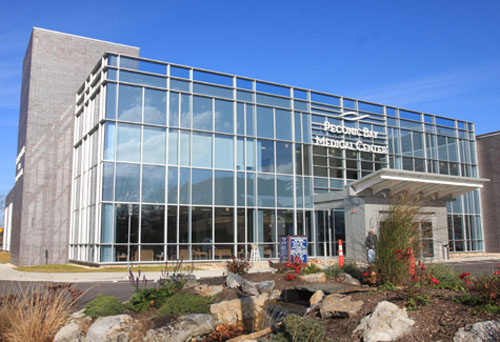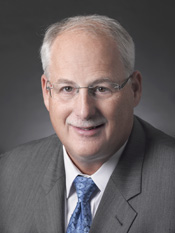The Year in Health 2013: New campus, new health care regulations

Between opening up a new campus in Manorville in September and major changes in health care on the horizon, 2013 was a busy year for PBMC Health chief executive officer Andrew Mitchell.
Going into his 13th year on the job at the Riverhead-based facility, Mr. Mitchell has had to remain as flexible as ever as changing federal health care regulations dominated much of the industry in the past year.

But Mr. Mitchell was able to take a few minutes to fill the News-Review in on where the industry may be headed next year, while reflecting on what 2013 brought about for PBMC Health.
Q: Shortages in primary care have been reported nationwide. Do you believe that trend is affecting North Fork residents? If so how?
A: We’ve made major investments in primary care. We have numerous practice sites that are sponsored by the medical center all over the North and South forks and while we believe that primary care shortage is an issue, we are working diligently to ensure that residents have access to outstanding primary care physicians. We employ probably 15 or so primary care physicians who are distributed between the North and South forks.
Q: What types of outpatient care and/or facilities do you believe area residents are lacking most?
A: I don’t think it’s outpatient care they are lacking. I think the most significant issue is the lack of an advanced cardiac catheterization unit for East End residents. Patients who require cardiac catheterization, either on an emergency or elective basis, have to travel great distances to get that care, putting — quite frankly — their lives at risk.
When you look at the makeup of our population and the incidence of heart disease, it is absolutely the number one health issue for residents of the East End.
Q: Should area residents be more concerned than before about their likelihood of contracting a tick-borne disease?
A: No. I think virtually all of our primary care and infectious disease physicians are highly aware of the diseases associated with ticks and are very vigilant about monitoring patients for those potential diseases.
Q: The CDC calls antibiotic resistance ‘one of our most serious health threats.’ What steps is the hospital taking to ensure the safety of its patients?
A: It goes way beyond the hospital. We see ourselves today not as a hospital but as a fully integrated health system with ambulatory campuses, physician offices, home health agency, a skilled nursing facility — I could keep on going down the list. So antibiotic selection, antibiotic usage and the whole issue of antibiotic resistance is a focal point of the entire continuum of care of PBMC Health. Through our pharmacy and therapeutics committee and our quality management program, we look very carefully at the use of antibiotics, We look very carefully at their use in association with surgery and, since we are a health system, in the ambulatory and physician office environment as well.
Q: What concerns you most regarding the implementation of health care reform come January?
A: The change is happening very rapidly and implementation of health care reform has not always been happening according to the originally stated plan, so that requires health care systems like PBMC Health to adapt to the unplanned changes very quickly and to be very nimble in the current environment. So whether it’s the delayed implementation of the health care exchanges, the decision that small business doesn’t have to participate for another year — all those have an impact on the health system, and we need to make adjustments.
Changes being made by Medicare outside health care reform are happening just as dramatically and are causing us to make significant changes to the way we, and all hospitals, have to operate. That has to do with the so called “observation status” that has been created by Medicare.
Q: PBMC recently opened and continues to work on the Manorville campus. How will this advancement help handle the expected influx of patients with health care reform?
A: Health care reform is clearly changing the way the health care industry is proving care by incentivizing preventive and ambulatory care. So we think of the Manorville campus, The Gertrude & Louis Feil Campus, as our model ambulatory campus and we think it’s the wave of the future. I think one piece of really interesting data is that we’ve already seen volume levels that we anticipated in the third year of operation in what is now the third month.
It’s interesting; we’re seeing what’s clearly a national trend where convenience is very important to patients. What we’ve seen right out of the gate is a very, very high utilization of our urgent care center, where patients can walk in and get care without an appointment in an expeditious way – and not have to worry about taking a day off of work … I think in Manorville, because there was such a lack of physicians’ offices in the region, that what we’re really just seeing there is the actual demand from the community.
We plan to open more of these facilities in 2014.
Q: Are there any exciting changes or advancements planned for 2014?
A: We’re planning on continuing to expand our Manorville campus. Manorville has already been a success and it’s not even completed. We’ll be opening two more buildings on the campus in 2014 so it will be almost three- quarters completed next year. We’re looking to replicate that in other parts of the service area. We do have a multi-campus plan.
On the main campus we have some technology upgrades and program upgrades in surgery. We expect to open a surgical progressive care unit, another private room unit for higher acute surgical patients.
In 2014 we are going to focus our philanthropic initiatives around the growth of an endowment for the health system and we anticipate some major gifts that will allow us to build the surgical progressive care unit and upgrade our intensive care unit.
We’re also in the middle of a cosmetic remodeling of all the inpatient units. The private room inpatient units in the Kanas Center were received so well we are starting to replicate that appearance in the rest of the inpatient rooms.


